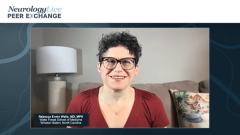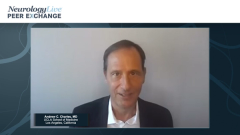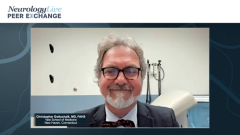
The Changing Landscape of Preventative Migraine Treatments
A panel of expert neurologists shares advice for community neurologists on preventive migraine treatment and exciting therapies to look forward to.
Episodes in this series

Jessica Ailani, MD: Before we get to the end of this program, it would be wonderful to give everyone a moment, 1 at a time, starting with Rebecca. Do you have any final words about this extremely exciting time in our field? Do you have any last words to give our audience members about what it’s like being a headache specialist with all the fun that we’re having?
Rebecca Erwin Wells, MD, MPH: Thank you so much, Jessica. Yes, this is an exciting time to be in the field and caring for patients. One of the things that a lot of these new treatment options has done is bring awareness to migraine and to the many patients who experience migraine, that it’s not just a headache. Now there’s even a hashtag, “#NotJustAHeadache” because migraine is a complex neurological disorder. For some patients, the photophobia, or phonophobia, or nausea is more disabling than the headache pain itself and recognizing that a migraine attack has a prodromal period and lasts a long time. With the new CGRP options, we have a new pathophysiological target, and as Chris mentioned, it’s not viewed as being all in your head. Now we have neurobiological evidence with targets specifically affecting the outcomes of patients with migraine.
It’s so important to recognize what a burden this is on patients. And how important it is to decrease the stigma and take away the guilt and blame from individual patients and say, “This is a neurological disease, and we can do so many things to help you with this.” Ultimately it’s a neurological disease, and the awareness of migraine is critical because there are many people who aren’t aware of the impact that migraine can have on patients’ lives. We’re at a great point in history in terms of being able to have and offer so many treatment options.
Jessica Ailani, MD: Andy, any last words?
Andrew C. Charles, MD: I agree with the point that having specific biology as a therapeutic target really goes a long way in reducing stigma. People can focus on the specific mechanisms rather than having this nebulous potentially functional emotional issue. There may be layers of those things that are important, but it’s validating for people to understand that there’s been research that’s done that’s identified this target in migraine patients now that treatments are exploiting it with, in some cases, spectacular effects. That’s exciting.
For me, as a scientist, the other incredibly exciting thing is that every time we have 1 of these major therapeutic advances, it has the potential to transform our understanding and we can take back to the bench what we’re learning at the bedside and try to understand where CGRP is being released, where are the receptors important, and then use that information to get better at individually treating specific patients with migraine.
Jessica Ailani, MD: Stephanie?
Stephanie J. Nahas, MD, MSEd, FAHS, FAAN: I aspired to become a neurologist because I’m fascinated with the nervous system, especially the brain. But I didn’t aspire to become a headache specialist because I had no idea that becoming a headache specialist could feed that desire of understanding how the nervous system works, how our brains tick, how we tick. That’s been 1 of the most exciting and gratifying things for me landing in this career path. The other thing I will reiterate is the gratitude you receive from patients is so gratifying. The specialty of headache medicine is antiburnout way more than any other specialty could be. Maybe plastic surgery—I don’t know. No, that’s a joke. But we all have our bad days, there are lots of challenges, and we get burned out too. Our risk for burnout is a little lower, partly because we’re learning about the tools to combat burnout because those are the same tools that our patients with migraine can employ. If you’re not already excited about headache medicine, I hope folks start to get in the game, because you can’t make a difference in people’s lives, but you can make a difference in your own life.
Jessica Ailani, MD: That’s a good point. I had a student who was like, “This is amazing.” She’s going into neurology, and she’d spent weeks as a sub-investigator. She said that was the first clinic that was a positive experience because everybody was so friendly and happy and doing well. I said, “You happened to come on 1 of those happy CGRP, days but I won’t say anything.” It was a great day to have somebody validate that what we do is so amazing. I hear you, Steph. Chris?
Christopher Gottschalk, MD, FAHS: I agree with all that. I love what you said, Stephanie, about the path you took to headache medicine. It occurred to me, at some point after I had become a headache specialist, that a lot of the illnesses that people focus on in neurology are things that happen to the nervous system, and that we can understand based on localization. But migraine is 1 of the best examples we have of an intrinsic disorder of the nervous system and the education that it provides, the insight it provides into the interactions between the cortex, and the thalamus, and the pain system. All the ways they affect different dimensions of function are absolutely fascinating. I get a thrill every day out of educating patients and giving them a different framework for understanding their own experience. They can then come back and say, “You’re right. If I look at this in a different way, I can treat it better. I can understand my symptom complex better. It’s much less of a sense of blame about what I did wrong and understanding how this process occurs.” Those are good days and good ways to motivate more practice and insight.
Jessica Ailani, MD: Thank you to our audience for watching this Neurology Live® Peer Exchange. I hope you’ve enjoyed watching this program as much as we’ve enjoyed spending this time together. If you’ve enjoyed this content, please subscribe to our e-newsletters to receive upcoming Peer Exchanges and other great content right in your in-box.
Transcript edited for clarity.
Newsletter
Keep your finger on the pulse of neurology—subscribe to NeurologyLive for expert interviews, new data, and breakthrough treatment updates.






























